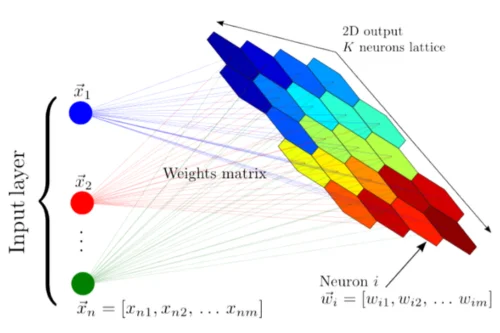Master´s Degree in Agile Methodologies and Digital Transformation + 60 ECTS Credits
Índice
Self-organizing maps (SOMs), also known as Kohonen maps, are a type of artificial neural network that is trained using unsupervised learning to produce a low-dimensional (typically two-dimensional), discretized representation of the input space of the training samples, called a map. In simpler terms, SOMs are used to visualize high-dimensional data in a lower-dimensional space while preserving the topological relationships between the data points. This makes them a powerful tool for dimensionality reduction and data visualization.

A SOM consists of a grid of nodes, where each node is associated with a weight vector. The weight vectors are initialized randomly at the beginning of the training process. During training, the SOM learns to map the input data onto the grid in such a way that nearby nodes represent similar data points. This is achieved through a competitive learning process.
When a new data point is presented to the network, the SOM calculates the distance between the data point and each weight vector. The node with the weight vector that is closest to the data point is called the best matching unit (BMU). The BMU and its neighbors are then updated to be more similar to the input data. The extent to which the neighbors are updated is determined by the neighborhood function and the learning rate.
There are many software packages that can be used to implement SOMs, including:
Self-organizing maps have a wide range of applications across various fields. Here are a few examples:
There are several variants of self-organizing maps, each with its own unique characteristics and applications. Some of the most common variants include:
While self-organizing maps are a powerful tool, they do have some limitations:
Despite these limitations, self-organizing maps remain a valuable tool for data analysis and visualization. By understanding the strengths and weaknesses of SOMs, researchers and practitioners can effectively apply them to a wide range of applications.
Self-organizing maps are a powerful tool for data analysis and visualization. They have a wide range of applications in fields such as biology, engineering, and finance. While SOMs have been around since their introduction by Teuvo Kohonen in the 1980s, they continue to be an active area of research.

¡Muchas gracias!
Hemos recibido correctamente tus datos. En breve nos pondremos en contacto contigo.